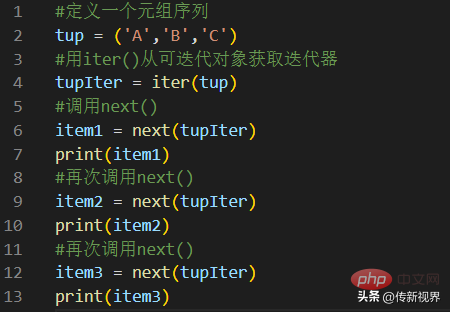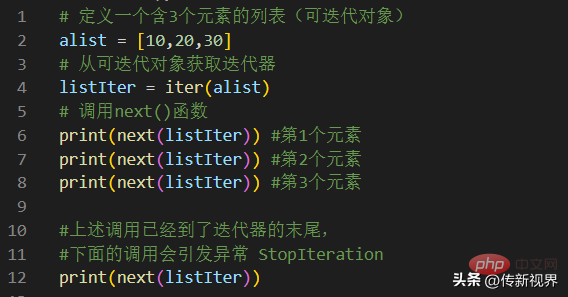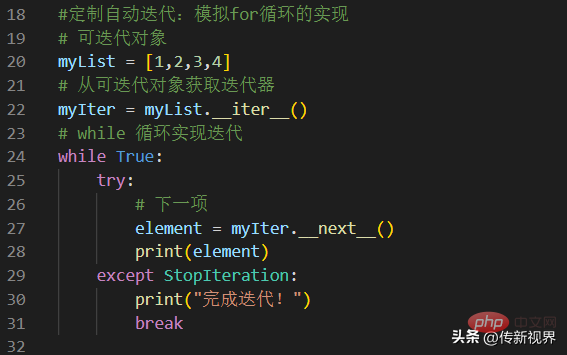 Backend Development
Backend Development
 Python Tutorial
Python Tutorial
 Iterator protocol and traversal methods in Python programming
Iterator protocol and traversal methods in Python programming
Iterator protocol and traversal methods in Python programming
Preface
The introduction of the previous part should make it easy for us to understand and master iterable objects and iterators (Iterable & Iterator) in Python. In this content, we will further introduce the related content of iterators.

1) __iter__(): This method of
object returns the iterator object itself. This is required for containers and iterators to be used with for-in statements. You can also use the built-in iter() function, which essentially calls the __iter__() method behind the scenes.2)__next__():
Return the next item from the iterator. If there are no other items, a StopIteration exception is thrown. You can also use the built-in next() function to read the next item, which is essentially calling the __next__() method. As we said before, lists, tuples, dictionaries and sets are all iterable types. In other words, they are types from which iterators can be obtained. Look at the example:
A B C

P y

| ##10 ##20 30 ##Traceback (most recent call last): ##File ……, in StopIteration In the above code, the next() function is called four times, which is more than the number of items in the iterator. In the last call, a StopIteration exception was thrown - because the elements in the iterator have been iterated. Moreover, in order to ensure that exceptions may be thrown after the manual iteration is completed, exception handling must be performed by yourself, otherwise the subsequent execution will no longer be normal. What needs to be realized is: in most scenarios, we do not need to manually call the next method ourselves. The for loop in Python can automatically traverse any object that can return an iterator. In other words, a for loop can iterate over any iterable object in Python. Please see the example: Code List Snippet 04 In the above code, we use a for loop to traverse the list defined earlier. It is obvious that we did not use the next() function manually and did not get any StopIteration exception. This is the beauty of for loops in Python. It handles all of this for us behind the scenes. Of course, we can handle loop iteration ourselves this way. Now define our own version of the for loop. We will use a while loop and replicate the behavior of a for loop. Here we build everything needed for this implementation ourselves. As shown below: Code Listing Snippet-05 In the above listing, we have implemented our own version of a simulated for loop. An infinite while loop is used in the code: while True. A try-except block is set up inside the loop. In the try block, get the next element by calling the __next__() method on the iterator. If the call is successful, the element is printed. If an error of type StopIteration occurs, the exception is caught in the except block. What you do in the except block is very simple. We just break out of this loop, which means we've reached the end of the iterator. That’s it for this article, which mainly introduces the iterator protocol and iterator traversal. The text of the content is not long, and combined with the code can help you better understand and master these Python programming knowledge points. |
The above is the detailed content of Iterator protocol and traversal methods in Python programming. For more information, please follow other related articles on the PHP Chinese website!

Hot AI Tools

Undresser.AI Undress
AI-powered app for creating realistic nude photos

AI Clothes Remover
Online AI tool for removing clothes from photos.

Undress AI Tool
Undress images for free

Clothoff.io
AI clothes remover

Video Face Swap
Swap faces in any video effortlessly with our completely free AI face swap tool!

Hot Article

Hot Tools

Notepad++7.3.1
Easy-to-use and free code editor

SublimeText3 Chinese version
Chinese version, very easy to use

Zend Studio 13.0.1
Powerful PHP integrated development environment

Dreamweaver CS6
Visual web development tools

SublimeText3 Mac version
God-level code editing software (SublimeText3)

Hot Topics
 PHP and Python: Different Paradigms Explained
Apr 18, 2025 am 12:26 AM
PHP and Python: Different Paradigms Explained
Apr 18, 2025 am 12:26 AM
PHP is mainly procedural programming, but also supports object-oriented programming (OOP); Python supports a variety of paradigms, including OOP, functional and procedural programming. PHP is suitable for web development, and Python is suitable for a variety of applications such as data analysis and machine learning.
 Choosing Between PHP and Python: A Guide
Apr 18, 2025 am 12:24 AM
Choosing Between PHP and Python: A Guide
Apr 18, 2025 am 12:24 AM
PHP is suitable for web development and rapid prototyping, and Python is suitable for data science and machine learning. 1.PHP is used for dynamic web development, with simple syntax and suitable for rapid development. 2. Python has concise syntax, is suitable for multiple fields, and has a strong library ecosystem.
 Python vs. JavaScript: The Learning Curve and Ease of Use
Apr 16, 2025 am 12:12 AM
Python vs. JavaScript: The Learning Curve and Ease of Use
Apr 16, 2025 am 12:12 AM
Python is more suitable for beginners, with a smooth learning curve and concise syntax; JavaScript is suitable for front-end development, with a steep learning curve and flexible syntax. 1. Python syntax is intuitive and suitable for data science and back-end development. 2. JavaScript is flexible and widely used in front-end and server-side programming.
 PHP and Python: A Deep Dive into Their History
Apr 18, 2025 am 12:25 AM
PHP and Python: A Deep Dive into Their History
Apr 18, 2025 am 12:25 AM
PHP originated in 1994 and was developed by RasmusLerdorf. It was originally used to track website visitors and gradually evolved into a server-side scripting language and was widely used in web development. Python was developed by Guidovan Rossum in the late 1980s and was first released in 1991. It emphasizes code readability and simplicity, and is suitable for scientific computing, data analysis and other fields.
 Can vs code run in Windows 8
Apr 15, 2025 pm 07:24 PM
Can vs code run in Windows 8
Apr 15, 2025 pm 07:24 PM
VS Code can run on Windows 8, but the experience may not be great. First make sure the system has been updated to the latest patch, then download the VS Code installation package that matches the system architecture and install it as prompted. After installation, be aware that some extensions may be incompatible with Windows 8 and need to look for alternative extensions or use newer Windows systems in a virtual machine. Install the necessary extensions to check whether they work properly. Although VS Code is feasible on Windows 8, it is recommended to upgrade to a newer Windows system for a better development experience and security.
 Can visual studio code be used in python
Apr 15, 2025 pm 08:18 PM
Can visual studio code be used in python
Apr 15, 2025 pm 08:18 PM
VS Code can be used to write Python and provides many features that make it an ideal tool for developing Python applications. It allows users to: install Python extensions to get functions such as code completion, syntax highlighting, and debugging. Use the debugger to track code step by step, find and fix errors. Integrate Git for version control. Use code formatting tools to maintain code consistency. Use the Linting tool to spot potential problems ahead of time.
 How to run python with notepad
Apr 16, 2025 pm 07:33 PM
How to run python with notepad
Apr 16, 2025 pm 07:33 PM
Running Python code in Notepad requires the Python executable and NppExec plug-in to be installed. After installing Python and adding PATH to it, configure the command "python" and the parameter "{CURRENT_DIRECTORY}{FILE_NAME}" in the NppExec plug-in to run Python code in Notepad through the shortcut key "F6".
 How to run programs in terminal vscode
Apr 15, 2025 pm 06:42 PM
How to run programs in terminal vscode
Apr 15, 2025 pm 06:42 PM
In VS Code, you can run the program in the terminal through the following steps: Prepare the code and open the integrated terminal to ensure that the code directory is consistent with the terminal working directory. Select the run command according to the programming language (such as Python's python your_file_name.py) to check whether it runs successfully and resolve errors. Use the debugger to improve debugging efficiency.







